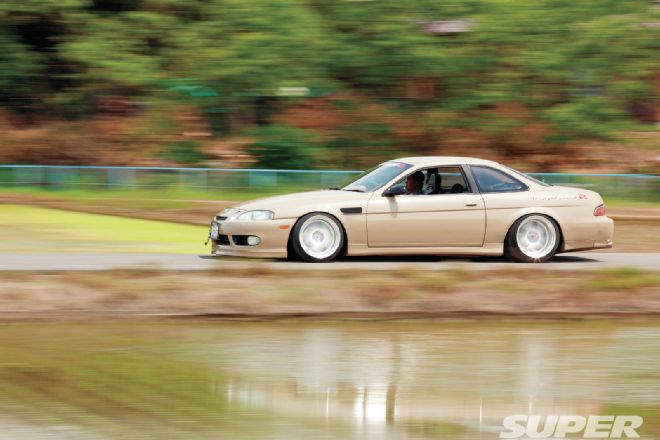“Patience and time do more than strength or passion,” said Jean de la Fontaine, the French Fabulist poet (d. 1695). To many this may be an excellent mode of thought, however the exact opposite is all excessively true nowadays. While modern society is just one of instant gratification, many frown upon the directions we’ve taken for that reason. There’s also something to become said for living life in the moment. Time, in fact, cannot be replenished; once we’re done, that’s it.
De la Fontaine may have been content to fritter away his life and let things happen to him, Forrest Gump-style, but the type-A Hideki Nagahama better embraces Andrew Jackson’s philosophy: When the time for action arrives, stop go and thinking in.” Nagahama-san, of Gunma Prefecture in Japan, has owned a series of fun rear-drive Toyotas over the years such as a Chaser, Mk II, Aristo, even a Celsior, although “Take time to deliberate. But he loves Toyota’s big rear-drive coupe Soarer the most, and he loves drifting. Put the two loves together and there wasn’t a lot of fumfering about in figuring out what he desired to do. In fact, the entire project took just a month. 4 weeks! Think about that for a second. Most of us can’t even get our cars out and in of paint in that amount of time, a lot less build a complete running, functioning drift car with aftermarket engine and chassis parts, plus body modifications to boot. Granted, he owns a shop, N-Style Custom, and can dispatch his minions to function on his car for as long as he required. Even so, one month is very littlesaving time is of paramount importance. What better place to start than under the hood? The big change to the 24-valve 1JZ is in the turbocharging. No reason to break into the lowest-compression engine already set up for boost; as an alternative to mess using the factory ceramic-impeller twin turbos that gained a history of exploding at high boost levels, Nagahama-san upgraded into a single twin-scroll Kinugawa (Garrett) T67-25G 8C huffer. Though just a single turbo, the twin-scroll design means that the exhaust gas’ kinetic energy is more efficiently scavenged; there’s also better pressure distribution in the exhaust ports, and better delivery of exhaust gas energy on the turbine. Faster spooling and quicker response are the upsides there. This also allows greater valve overlap, allowing a cleaner and denser air charge in the cylinders-which needless to say means more power. Also you can introduce an ignition delay, which keeps cylinder temperature down; lower exhaust gas temperatures mean a leaner air/fuel ratio, meaning better mileage to boot. (As if Nagahama-san is worried about fuel mileage.) A greater exhaust to funnel the gasses, enough fuel pressure to satiate the engine’s hunger, and you get a whopping 450 pferdestrake on the international power scale; about 443 horsepower, or nearly double what was available on the Lexus SC400 when it launched in this country in mid-1991 being a 1992 model. Rather than hope for the best with the stock R154 five-speed stick, Nagahama-san installed a German-built Getrag V160 six-speed, pirated from a twin-turbo Supra; it required little more than a twin-plate clutch to beef it.
Could use a bit tightening up for track duty, even though stock Soarer suspension-double-wishbones front and back, with coil springs and shock absorbers-are outstanding for that street. Out go the springs and shocks, and in come a set of Aragosta coilovers, which both stiffen and drop. Engineering the vehicle’s height was the single toughest portion of the build, Nagahama-san reports; the flares, the drop, the camber, the wheels… all had to be carefully sorted, lest he will need to go back and do things twice. And you’ll never save time doing this.
Now, about that color. It’s a surprising someone to Western eyes; the pearl white-painted SSR Professor hoops give it a greater portion of a sun-tanned vibe, but there’s little getting throughout the impression that this color is slightly fleshy. It’s called Milk Tea Beige Metallic, which is as near as we can tell a 2008 home-market Suzuki color, and also the name goes a long way toward explaining its presence: calming yet caffeinated, gentle yet flavorful, milk and tea are as traditional a drink as you’ll find in Japan. One of Nagahama-san’s previous Soarers was red, and that one was as bright as this one is mild. We let it rest to you to divine whether this shade is your cup of, er, well you understandjust over an inch and a half) on each corner, as a way to accommodate the super-sized 18-inch rolling stock. Nagahama-san figured that this was the toughest item around the whole car to make look and work right: “Pulling out the fender too much is not a good idea,” Nagahama-san suggests. There’s more: the front airdam remains an early piece, but a later Kouki third-gen Soarer donated its bumpers and side skirts to offer a slightly more up-to-date look. That look can frequently be seen driving sideways around the drift tracks of Japan. Although it’s not parked much, and although it’s antiseptic in its preparation, Nagahama-san clearly has places to go and things to do.
Something Nagahama-san’s quick-build Soarer teaches us about saving time: You’re gonna get clocked if you’re not paying attention.
